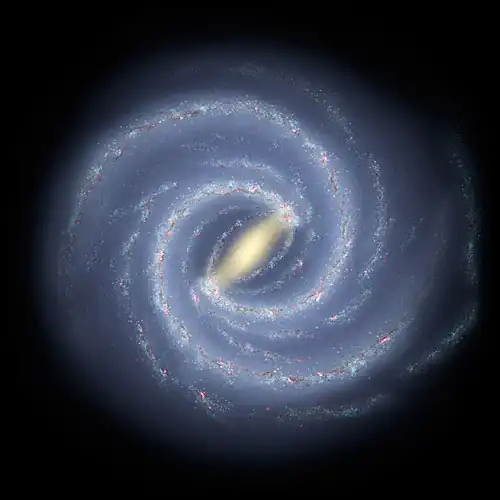| Ursa Major III | |
|---|---|
| Observation data (J2000 epoch) | |
| Constellation | Ursa Major |
| Right ascension | 11h 38m 49.8s[1] |
| Declination | +31° 04′ 42″[1] |
| Distance | 32.6±3.3 kly (10±1 kpc)[1] |
| Absolute magnitude (V) | +2.2+0.4 −0.3[1] |
| Characteristics | |
| Type | dSph[1] |
| Mass/Light ratio | 6500[1] M☉/L☉ |
| Number of stars | 57+21 −19[1] |
| Half-light radius (physical) | 3±1 pc[1] |
| Half-light radius (apparent) | 0.9′[1] |
| Other designations | |
| UMa III, UNIONS 1 | |
Ursa Major III is an incredibly faint and small satellite galaxy of the Milky Way, the faintest and smallest ever discovered. Ursa Major III was discovered in the deep, wide field Ultraviolet Near Infrared Optical Northern Survey (UNIONS), and its discovery was announced in November 2023. It contains a very old (over 11 Gyr old), metal-poor stellar population located about 10 kiloparsecs away, or about 32,600 light years away. Ursa Major III only has a radius of about 9.8 light years, and its absolute magnitude is only +2.2, making it by far the Milky Way's dimmest satellite, and only about as bright as Altair. This absolute magnitude corresponds to a stellar mass of 16 M☉. Only about 60 stars are predicted to exist within Ursa Major III.[1]
Ursa Major III is predicted to have a mass-to-light ratio of about 6,500, however this becomes only 1,900 with the removal of one of the stars suspected to be part of the galaxy. This very high value indicates the presence of a massive dark matter halo, indicating that Ursa Major III is indeed a true dwarf galaxy, albeit one with an extremely low stellar mass.[1] As Ursa Major III's total luminosity is approximately 11.4 L☉, its total mass is probably only about 74,000 M☉, which would make it one of the least massive galaxies known.
References
- 1 2 3 4 5 6 7 8 9 10 11 Smith, Simon E. T.; Cerny, William; Hayes, Christian R.; Sestito, Federico; Jensen, Jaclyn; McConnachie, Alan W.; Geha, Marla; Navarro, Julio; Li, Ting S. (2023-11-01), The discovery of the faintest known Milky Way satellite using UNIONS, arXiv:2311.10147, retrieved 2023-12-21

.png.webp)
